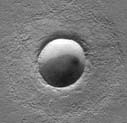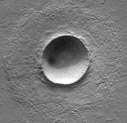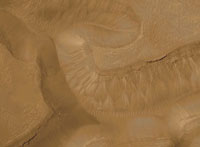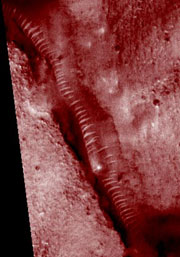
| Bad Astronomy |
|
|
|
BA Blog
|
|
Q & BA
|
|
Bulletin Board
|
| Media |
|
|
|
Bitesize Astronomy
|
|
Bad Astro Store
|
|
Mad Science
|
|
Fun Stuff
|
| Site Info |
|
|
|
Links
|
| RELATED SITES |
| - Universe Today |
| - APOD |
| - The Nine Planets |
| - Mystery Investigators |
| - Slacker Astronomy |
| - Skepticality |
Buy My Stuff

Keep Bad Astronomy close to your heart, and help make me
filthy rich. Hey, it's either this or one of those really
irritating PayPal donation buttons here.
The "Glass Worm"
Contents of this page
Introduction to the Glass Worm
Mars is a weird place. No one argues that. I think the argument might be over just how weird Mars is. For example, does Mars host a species of giant glass worms, 50 meters across and kilometers long?I'm guessing no.
 So why would anyone, let alone someone on
Richard Hoagland's website,
say otherwise? Well, probably because of the image shown on the right
(clicking on it will display a much larger version), taken by the
Mars Orbiter Camera
onboard the
Mars Global Surveyor.
It's not hard to interpret this image
as some long, convex, glass-like structure.
It really does look like it's an enclosed tube. It looks shiny, and
the arcs going across it look like for all the world (or worlds) like
ribs, or the little segments in an earthworm.
So why would anyone, let alone someone on
Richard Hoagland's website,
say otherwise? Well, probably because of the image shown on the right
(clicking on it will display a much larger version), taken by the
Mars Orbiter Camera
onboard the
Mars Global Surveyor.
It's not hard to interpret this image
as some long, convex, glass-like structure.
It really does look like it's an enclosed tube. It looks shiny, and
the arcs going across it look like for all the world (or worlds) like
ribs, or the little segments in an earthworm.
On Hoagland's website, he has a page about all this written by Ron Nicks, who claims to be a geologist. Nicks makes lots of claims about this feature, and in fact says the following:
| This remarkable "tube," roughly a mile in length and hundreds of feet wide, appears to cling to a desert canyon wall near the canyon's bottom, and extend along its entire length. The feature has the appearance of being "translucent," of being supported at somewhat regular intervals by "ribs," and of being quite cylindrical -- with a localized, internal structure at one point of considerably higher albedo (brightness). |
[Note added March 30, 2004: In the original version of this article, I said that Ron Nicks was concluding this feature was an actual living worm at some point in the past. I was wrong. He does not say this in reality; he actually says that the lack of food for something this size precludes a natural biological origin for it (he does claim it is some sort of construction project, though). When I read the article, I misread that statement. However, this doesn't negate the other points I make below, especially the key one about optical illusions.]
Nicks' description is wrong in almost every detail he describes.
Now, most people looking at the image would certainly agree with
Nicks' analysis at first. I mean, it does look like a worm!
It looks so much like a worm that no less a figure than
Arthur C. Clarke has commented on it.
In
I will state here that I am a great fan of Sir Arthur's. His
stories helped inspire me to be an astronomer.
It is not too much of a stretch to say that we owe
our very presence in space to Arthur C. Clarke! But I think that
in this case, I must disagree with him. This thing isn't a worm at
all, and in fact has few of the properties ascribed to it by
Nicks (speaking for Hoagland by proxy) and others.
First off, they claim the object is convex, that is, popping out
of the image as opposed to being a concave valley. However, I think
this claim is false. To see why, look at the
images below. They demonstrate an illusion where craters can look
like domes if flipped upside-down.
This illusion is pretty cool, though some people have a harder time
seeing it than others. Ironically, it is not all that strong to me
in the pictures above, but my wife thought it was remarkable how much the
image on the left looked like a dome. I have seen
other examples, though, and this illusion can be pretty convincing.
But does it work for the worm? Let's see:
As far as I am concerned, this makes it pretty clear right away that
Nicks' (and therefore Hoagland's) claims about this feature
are completely wrong. If it's not a convex tube, then everything else
he says is perforce wrong.
But the transverse features are still odd-looking. What are they?
Well, to me they look like sand dunes. Mars is a very sandy place, and
has lots of wind. I've spent some time on beaches, and I know
that wind + sand = sand dunes. In fact, Mars is littered with sand dunes.
That does not necessarily mean these features are
definitely sand dunes, but it's the most likely explanation.
Of course, a lot of pseudoscientists are saying these features cannot
be dunes. Nicks says this in his page on Hoagland's site.
On that page, he actually says he tries to be fair, and
includes comments from someone saying that these are dunes. Nicks then
dismisses that, saying that the winds could not possibly follow
along the winding formation. But he's saying that because
he thinks it's raised above the surface, convex, and not a channel.
Sure, if that feature
were a long windy worm coming up out of the surface, no wind could
blow along it. But it's not a worm, it's a carved depression
in the surface. Winds can easily flow into and down such a channel, following
the winding, meandering depression. That would naturally form dunes.
Not that this has stopped Hoagland, of course. On his website,
in a page about the Face, he mentions
this "worm" again,
and says:
It's not simplistic, it's simple. Ironically,
Hoagland is complaining that
scientists tend to cling to ideas. Yet he is the one clinging to this
being a convex feature, when it just ain't. So his whole
premise is wrong from the very start.
I feel that I should also mention that there is another explanation
for these features. To me, they look like ridges you get in stream beds.
As water flows,
it naturally generates ridges like these, similar to the annoying ridges
you get in dirt roads that make your car vibrate when you drive over them.
I am not saying this is more or less likely than the ridges being dunes,
but it is an alternate explanation. I'm not a geologist, so I cannot
say one way or the other. Maybe I'll suggest it to one
of the Mars scientists, and see what they say. It's better than
idly speculating, and is far more likely to yield better results.
What about the glassy appearance of the "worm"?
Nicks makes this point a few times
in his writing, and
other pseudoscience websites have talked about this as well.
There are some bright features that look
like sunglints, reflections of off a shiny object. But there is another
explanation.
I think that is the case here as well. I took the image and played with
it just a bit in Photoshop. I made the image red, and changed the contrast a
little. Suddenly, the "glassy" appearance is gone, and
it looks more like what it really is: a long winding channel with
ridges. This in itself shows that the interpretation of glassiness
depends on how the image is displayed, and not necessarily on any
intrinsic shininess of the feature.
So what have I shown? Let's be clear:
So what we have here is yet another breathless claim by Hoagland and his
team which, when you think more carefully about it, is
grossly exaggerated at best. This isn't the fossil of some giant
glass worm. It's even more remarkable, in my opinion: it's evidence
that water once flowed on an alien planet. That is a fossil record
of far greater interest.
I've said it before and I'll say it again:
the Universe is an incredible place, fantastic enough that we don't have
to make up nonsense about it.
The Convex/Concave Con


Is it a dome...
... or a crater?


Is it a worm...
... or a valley?
Whatcha Dune?
 On the left is another region of Mars called
Gorgonum Chaos, which is a very cool name (click on the image
to see it in much higher resolution). There are gullies all through
this region, and they are consistent with flowing water. At the bottom
appear to be more entrained dunes. The channel in which they sit is
much more clearly a channel, and not a raised tube! So it looks
like Mars can make features like this in channels. It's not a stretch
at all to see that the same thing is happening in the valley
claimed to be a giant worm. In fact, it can happen
on crater floors, too, so it appears to be
a fairly common feature on dusty, sandy Mars.
On the left is another region of Mars called
Gorgonum Chaos, which is a very cool name (click on the image
to see it in much higher resolution). There are gullies all through
this region, and they are consistent with flowing water. At the bottom
appear to be more entrained dunes. The channel in which they sit is
much more clearly a channel, and not a raised tube! So it looks
like Mars can make features like this in channels. It's not a stretch
at all to see that the same thing is happening in the valley
claimed to be a giant worm. In fact, it can happen
on crater floors, too, so it appears to be
a fairly common feature on dusty, sandy Mars.
This is how you get the simplistic (and scientifically
absurd) "sand dunes" argument when geologists are confronted by
true anomalies like the "Glass Tunnels of Mars"
Pane in the Glass
 In digital images, the contrast in the image has to be chosen.
Someone turning the computer bits into a displayed image has to pick
the brightest thing to display as white. Anything brighter than that will
appear to be that same white.
So if you have a feature in an image that
is a little bit brighter than the surface around it, and you set it
to look white, then it will look shiny to your eye. It isn't shiny; it's
just a wee bit brighter.
In digital images, the contrast in the image has to be chosen.
Someone turning the computer bits into a displayed image has to pick
the brightest thing to display as white. Anything brighter than that will
appear to be that same white.
So if you have a feature in an image that
is a little bit brighter than the surface around it, and you set it
to look white, then it will look shiny to your eye. It isn't shiny; it's
just a wee bit brighter.
Conclusion
1) This is not a raised tube, like a worm on the ground, but a channel.
It's concave, not convex.
2) The ridges are in fact ridges, and not ribs or etchings. They
are most likely sand dunes entrained by aerodynamic forces (that is, wind).
3) The glassiness is another illusion, created by the contrast level in the
image.
4) This object, far from being inexplicable, is actually explainable
as a gully perhaps carved by water flow. The ridges are wind-entrained dunes or
possibly more solid erosion features from flowing water.
|
|
|
|